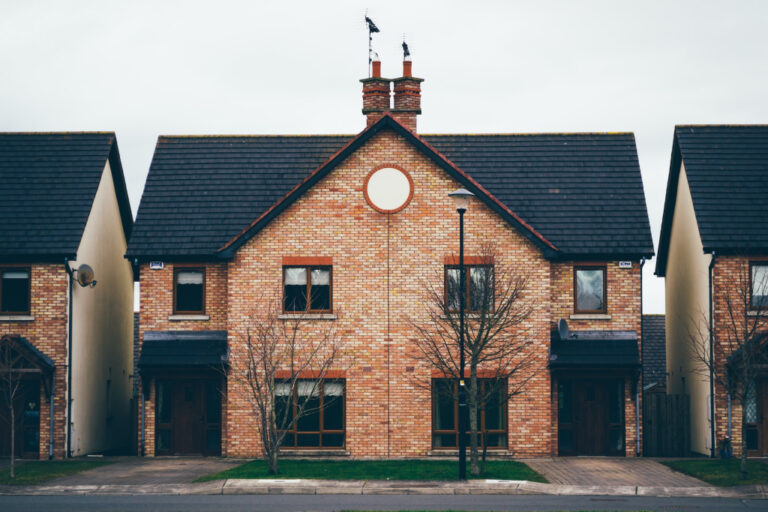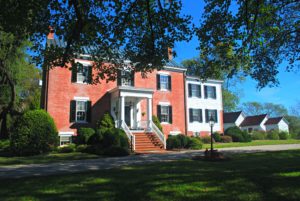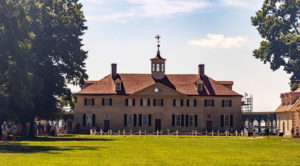Photo by Terrah Holly on Unsplash
A wealth of architectural masterpieces that have lasted for generations can be found in Virginia, a historically-steeped state in the United States. It has a fascinating past and visually-pleasing charm that will surely captivate you.
The state’s real estate market boasts various exquisite Virginia historic homes for sale, ranging from grand plantation estates to remarkable presidential historic homes.
These exceptional properties offer a one-of-a-kind opportunity to witness the elegance and allure of a past but not forgotten era while discovering the illustrious heritage of the place.
Step through the doors of the magnificent historic homes for sale in Virginia and be transported back in time.
Each room showcases the craftsmanship and architectural beauty that defined the era when they were built.
To put it simply, Virginia is the place where history comes alive. It is a must-visit location for anyone who loves learning about the old days.
Virginia is also the ideal location for those who want to settle down in a place rich in cultural heritage and tradition.
Let us unfold more about Virginia’s historic estates and presidential homes. We’ll explore the intricate details and discover the enduring beauty that makes these homes integral to the state’s cultural heritage.
Virginia Presidential Historic Homes

Photo by JamesDeMers on Pixabay
Virginia is famously referred to as the “Mother of Presidents,” as it has been the birthplace of eight highly respected leaders of the United States.
The first four founding fathers that became president of the country, namely George Washington, Thomas Jefferson, James Madison, and James Monroe, together with William H. Harrison, John Tyler, Zachary Taylor, and Woodrow Wilson, once called Virginia their treasured home.
The ancestral ties of these notable presidents to Virginia further reinforce the state’s profound connection to the American presidency.
It highlights the profound historical and cultural influence that the state has had on shaping the nation’s leaders.
It further solidifies the state’s status as a place of great significance in the books of American political history.
Six historic presidential homes are still open to the public for tours and exploration today! Let’s check them out one by one:
1. George Washington's Mount Vernon

Photo by Brandi Day on Pixabay
Mount Vernon is a stunning historic property on the banks of the scenic Potomac River in Virginia.
It was owned by the nation’s first president, George Washington, and his lovely wife, Martha Washington.
The exquisite Mount Vernon estate was built in the mid-18th century. It was initially intended as a modest plantation residence of Augustine Washington, the father of George Washington.
Over the years, the property has undergone extensive expansion and renovation, resulting in today’s iconic residential estate.
Mount Vernon is a prestigious historic site and museum readily accessible to the public. It hosts various educational programs, tours, and special events to captivate and engage visitors.
Guests can explore the museum and education center available at Mount Vernon, offering an immersive experience of the life and legacy of Washington.
Architectural Features
- Year Built: 1734
- Style: Neoclassical, British/Five-Part Palladian
- Number of Rooms: 21
- Lot Size: 7,600 acres
- Square Footage: 11,000 s
Interesting Facts
- James Madison initially inherited a modest-sized home. He transformed Montpelier into a grand mansion with multiple architectural upgrades and refurbishments throughout his ownership.
- The library at Montpelier houses over 4,000 volumes, making it one of the most extensive personal libraries of the time.
Location Details and Schedule
- 3200 Mount Vernon Memorial Hwy, Mt Vernon, VA 22121
- Open All Year Round, including Holidays
- April through October: 9AM to 5PM
- November through March: 9AM to 4PM
Admission Tickets
- Adults (Aged 12+): $28
- Youth (Aged 6-11): $15
- Children (Aged 0-5): FREE
- Guests aged 15 and under must be in the care of an adult.
2. Thomas Jefferson's Monticello

Photo by JamesDeMers on Pixabay
Monticello is a renowned historic home situated close to Charlottesville, VA. It was previously the historic estate and cherished home of Thomas Jefferson, the esteemed third President of the United States.
The construction of Monticello commenced in 1768, and for several decades, Thomas Jefferson meticulously refined and expanded the estate.
The property boasts a distinctive architectural style that seamlessly blends Neoclassical and Palladian influences, a testament to Jefferson’s affinity for classical design and forward-thinking concepts.
Tours around this luxurious mansion allow you to discover its many exquisite rooms, such as Thomas Jefferson’s private study.
Guests can also check out the unique characteristics of Monticello, including its striking dome and distinct octagonal rooms.
Monticello is a remarkable property that showcases the intellectual pursuits, architectural genius, and significant contributions of Thomas Jefferson as one of the United States’ founding fathers.
Presently, this historic presidential home in Virginia is a distinguished UNESCO World Heritage Site and a highly sought-after location for travelers and history buffs.
Architectural Features
- Year Built: Between 1769 and 1809
- Style: French Neoclassical, Palladian, Colonial Revival
- Number of Rooms: 35
- Lot Size: 5,000 acres
- Square Footage: 11,000 sqft
Interesting Facts
- The iconic “Dome Room” is one of several octagonal rooms in Monticello. Jefferson thought the octagonal shape was ideal because it made the most available space and light, resulting in a comfortable and aesthetically beautiful setting.
- Monticello’s Octagonal Dome was the first of its sort in the United States.
- The term “Monticello” is derived from the Italian language and translates to “hillock” or “little mountain,” which suits the property as it is perched on top of an 867-foot mountain.
Location Details and Schedule
Admission Tickets
- Ticket Prices Varies According to Your Chosen Tour Package
3. James Madison’s Montpelier
Montpelier is a distinguished presidential historical estate in the idyllic area of Orange, VA. James Madison, the fourth President of the United States and widely recognized as the “Father of the Constitution,” once made Montpelier his home.
It is a historic property constructed in the 1760s and underwent multiple expansions and renovations during the ownership of James Madison.
The estate boasts a harmonious fusion of architectural styles, seamlessly blending Georgian and Federal elements, which is a testament to the impeccable taste of its owner.
It features a stunning two-story main house adorned with a neoclassical portico and Palladian windows.
Guests can explore the exquisite interior of Montpelier and gain first-hand experience walking across James Madison’s library, where he conducted a significant portion of his research and writing.
A visit to Montpelier presents a unique opportunity to have a trip down memory lane into the rich history and enduring legacy of James Madison.
Plan your visit now and marvel at the exquisite architecture and historical significance of this treasured estate in Virginia!
Architectural Features
- Year Built: 1790
- Style: Georgian with Greek and Roman Accents
- Number of Rooms: 26
- Lot Size: 2,650 Acres
- Square Footage: Approximately 6,000 sqft
Interesting Facts
- James Madison initially inherited a modest-sized home. He transformed Montpelier into a grand mansion with multiple architectural upgrades and refurbishments throughout his ownership.
- The library at Montpelier houses over 4,000 volumes, making it one of the most extensive personal libraries of the time.
Location Details and Schedule
Admission Tickets
| Age Bracket | Ticket Price |
|---|---|
| Adult (Aged 18+) | $36 |
| Military (Active/Veteran) | $34 |
| Senior( 65+) | $34 |
| Youth (Aged 12 to 17) | $16 |
| Child (Aged 11 and Below) | FREE |
- Property Access:
- Annual Membership: Start at $50, with 10% discount from the Museum Shop
- Regular Rates:
| Age Bracket | Ticket Price |
|---|---|
| Adult (Aged 18+) | $13 |
| Youth (Aged 12 to 17) | $8 |
| Child (Aged 11 and Below) | FREE |
| Orange County Residents | FREE |
4. James Monroe's Highland
Highland is a remarkable plantation and museum situated in Charlottesville, VA.
The property once served as the home of the fifth President of the nation, James Monroe, and his spouse, Elizabeth Kortright Monroe, and their offspring.
It is locally known as Ash Lawn-Highland due to the magnificent ash trees that grace the property.
Highland is a magnificent home spanning a vast 535-acre site. It boasts of Monroe’s original farmhouse, which has been meticulously restored and furnished with exquisite period pieces.
The estate boasts an idyllic setting, complete with rolling hills and sweeping vistas, providing a breathtaking backdrop for exploration.
The Virginia countryside’s inherent allure further enhances this historic home’s enchanting appeal.
Presently, it is readily accessible to the public as a museum and an educational destination. It offers valuable insights and opportunities to explore meticulously maintained grounds while relishing in the picturesque vistas of the neighboring rural landscape.
Architectural Features
- Year Built: 1799
- Style: Victorian
- Lot Size: 535 Acres
Interesting Facts
- In addition to his work as a politician, James Monroe was also a dedicated farmer. Crop rotation and other scientific farming procedures were among the novel approaches he tried at his Highland farm.
- The Monroe Doctrine, a pivotal aspect of American foreign policy, was drafted by James Monroe at Highland. The doctrine firmly established the United States’ stance against any European colonization or intervention.
Location Details and Schedule
Admission Tickets
- General Admission:
- Adult (Aged 13 and above): $18
- Adult (Discounted Online Price): $17
- Youth (Aged 7 to 12): $13
- Child (Aged 6 and below): FREE
5. William Henry Harrison's Berkeley Plantation
Berkeley Plantation, located in Charles City County, Virginia, is known for its historical significance and connection to the presidency of William Henry Harrison.
The late president came from a prominent political family and went on to become the ninth president of the United States in 1841.
However, his presidency was short-lived as he caught pneumonia shortly after delivering his inaugural address and died just 32 days into his term, making him the shortest-serving U.S. president.
While Harrison did not own or reside at Berkeley Plantation, the property is linked to his family history.
Berkeley Plantation dates back to the early 17th century when Benjamin Harrison IV, the great-grandfather of William Henry Harrison, established the property.
Benjamin Harrison IV was a prominent figure in colonial Virginia and a signer of the United States Declaration of Independence.
Architectural Features
- Year Built: 1726
- Style: Georgian
- Lot Size: 1,000 Acres
Interesting Facts
- Berkeley Plantation is famous for its haunted status. When Benjamin’s father and two sisters tried to shut a window during a storm in 1744, they were struck by lightning and killed instantly. Legend has it that their spirits still haunt the home to this day. Many guests have reported seeing a ghostly vision of a sister carrying her infant brother at the mansion.
Location Details and Schedule
- 12602 Harrison Landing Rd, Charles City, VA 23030
- Gift Shop and Ticket Sales: Open Daily, 9:30AM to 4:30PM
- Guided House Tours: Every hour from 10AM to 4PM
Admission Tickets
- General Admission
- Adult (Aged 18+) – $17
- Senior (65+) – $15.50
- Children (Aged 6 to 12) – $7.50
- Military – $15.50
- Military Children (ages 6-12) – $7.00
- Annual Pass
- Adult – $50
- Child – $25
6. John Tyler's Sherwood Forest Plantation
Another renowned Virginia presidential historic home that can be found in Charles City County is the former residence of the tenth president of the United States, John Tyler’s Sherwood Forest Plantation.
It is a remarkable historic property distinguished by its expansive size and rich historical significance.
Following the passing of John Tyler in 1862, Sherwood Forest remained under the ownership of the Tyler family. It is still occupied by them ever since it was purchased by the former president in 1842.
Sherwood Forest Plantation has been officially recognized as a National Historic Landmark and is readily available for public tours.
Guests can explore the property and its surrounding estate, offering a unique glimpse into the historical significance of President John Tyler’s former residence.
It is a highly sought-after destination for individuals with a passion for history and a desire to know more about the nation’s formative era.
Architectural Features
- Year Built: 1730
- Style: Georgian, Virginia Tidewater
- Lot Size: 1,200 Acres
Interesting Facts
- Sherwood Forest Plantation has a dedicated pet cemetery, where the beloved animals of the Tyler family, including the renowned horse of John Tyler, The General, have been laid to rest.
Location Details and Schedule
- 14501 John Tyler Memorial Hwy, Charles City, VA 23030
- Open Daily, 9AM to 5PM
Admission Tickets
- Self Guided Grounds Tour:
- Per Person – $10.00
- Children (Aged 15 and below) – FREE
- Guided House Tour:
- Adult – $35
- School Aged – $25
Pros and Cons of Buying Historic Homes for Sale in Virginia

Photo by Evelyn Paris on Unsplash
Buying historic homes for sale in Virginia comes with various challenges and rewards. The decision to buy and own a historic property is a personal one that requires careful consideration and planning.
To help you decide, we have listed some of the pros and cons of buying Virginia historic homes for sale:
PROS:
| Lorem ipsum dolor sit amet, consectetur adipiscing elit | Lorem ipsum dolor sit amet, consectetur adipiscing elit |
|---|---|
| Distinct Charm and Character | Historic properties exude a special allure that is hard to find in newer constructions. These homes are known for their intricate craftsmanship, period-appropriate details, and timeless style. A historic property can provide a one-of-a-kind and fascinating lifestyle for those who value original architecture and the handiwork of past generations. |
| Investment Potential | The value of a historic home in a desirable area like Virginia is likely to remain stable or even rise over time, making it a good investment opportunity. Historic homes are becoming increasingly scarce, and as a result, their value is appreciating due to the ongoing demand from buyers and collectors. The housing market is known to be volatile. However, properties with historical significance located in sought-after areas such as Virginia have demonstrated a tendency to maintain their value and potentially appreciate over time. Because of this, they can be a smart bet for those searching for long-term investments that will grow in value. |
| Potential Tax Benefits | Owners of historically designated properties may be eligible for tax breaks, though this will vary by jurisdiction. Some examples of incentives that aim to support the preservation of historic properties are property tax credits or reductions and state or federal tax credits for rehabilitation or restoration work. |
CONS:
| Lorem ipsum dolor sit amet, consectetur adipiscing elit | Lorem ipsum dolor sit amet, consectetur adipiscing elit |
|---|---|
| Hefty Maintenance Costs | The cost of maintenance and repairs for historic homes is one of the important considerations if you are planning to buy one. Due to their age and distinctive construction, the property may be prone to wear and tear issues or deterioration. Additionally, most materials used to construct historic homes may be comparatively pricier or more challenging to procure, resulting in more expensive and time-consuming repairs than modern or newly-built residences. |
| Pricey Insurance Coverage | Aside from maintenance, insurance premiums for historic homes may also be higher than average. It is mainly due to the increased risk of damage or loss due to the property's age. For this reason, homeowners of historic homes need to consider these additional costs and factor them into their budget when deciding to purchase or maintain their property. Despite the higher costs, owning a historic home can be a unique and rewarding experience, as it provides a connection to the past and a sense of pride in preserving a piece of history. |
| Financing Challenges | Interested buyers of historic homes for sale in Virginia may encounter financing challenges when securing funding for these properties. Lenders may have specific requirements and limitations due to the unique characteristics and potential risks associated with older homes. |
It is advisable to seek guidance from seasoned real estate agents who have dealt with historic home purchases before making a final decision.
Conduct an extensive study on the property, and don’t hesitate to ask questions and clarify any concerns with the seller or agent before proceeding with the purchase.
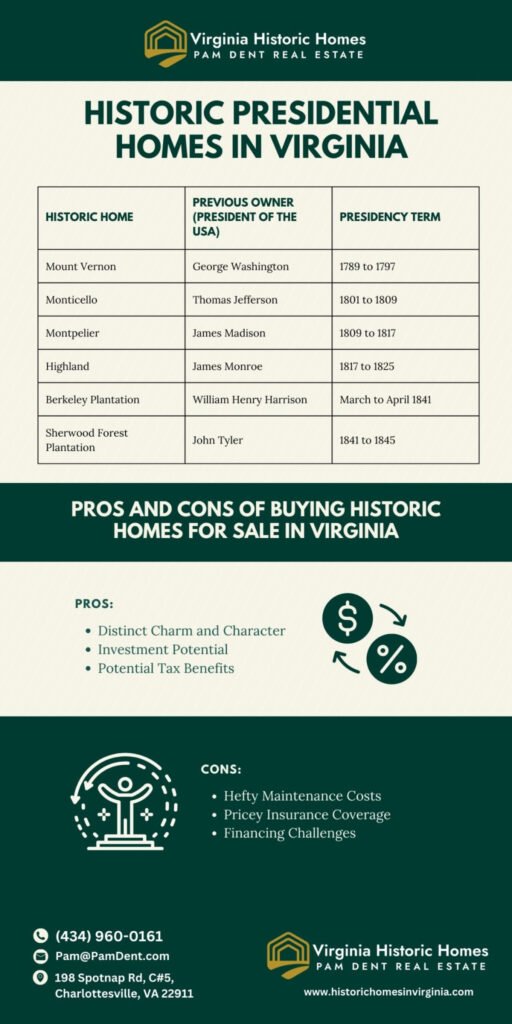
Conclusion
Exploring the historic presidential homes in Virginia offers a captivating journey through American history.
Historic homes are more than just relics of the past. They offer an opportunity for us to connect with history personally.
The benefits of visiting or owning a historic presidential home in Virginia extend beyond nostalgia and admiration.
They also serve as living monuments, reminding us of the principles that guide our nation and the importance of preserving our collective heritage.
On the positive side, owning a historic home offers a unique sense of pride and connection to the past. However, it is crucial to consider the responsibilities of owning a historic home.
Maintenance and repairs may require extra care and investment. Renovation restrictions are in place to preserve historical authenticity, and adapting these homes to modern living standards may pose challenges.
Are you planning to buy a historic home? Then entrust your home-buying journey with me!
With my well-established expertise and knowledge of the real estate market, I will assist you throughout the process, from property search to closing. Let us work together to make your dream of owning a historic home a reality!
You may book an appointment with me by calling (434) 960-0161 or emailing Pam@PamDent.com.
Stay updated with the current listings for Virginia historic homes for sale by following my social media platforms below.
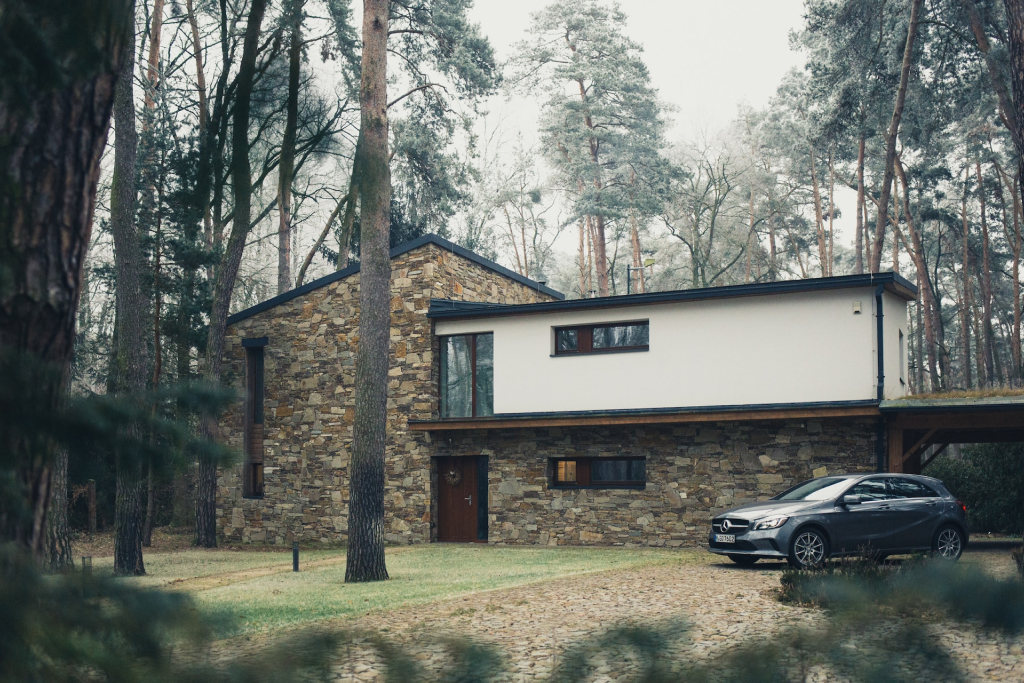
Photo by Flo Pappert on Unsplash
Frequently Asked Questions
What is the Landmarks Commission in Virginia?
One of the Landmarks Commission’s most notable efforts is compiling a list of Virginia’s most significant architectural, historical, and archaeological landmarks.
In its fourteen years of operation, the Commission has added more than 850 properties to the Virginia Landmarks Register.
What is the difference between a national register historic district and a local historic district?
National Register Historic Districts are areas identified as having exceptional historical, architectural, archaeological, or cultural value to the United States and have been added to the National Register of Historic Places.
As a result, property owners can gain access to federal historic preservation incentives and receive national recognition for their efforts without being subject to rules or regulations.
Meanwhile, Local Historic Districts are designated to safeguard and preserve the historic properties within their borders.
To protect the district’s historic character, local districts can legally enforce preservation criteria to prevent demolition or significant renovation that will significantly affect the property’s historic character.
How many historical sites are in Virginia?
Virginia is home to more than 120 historical sites, including national historic landmarks, memorials, and monuments.
